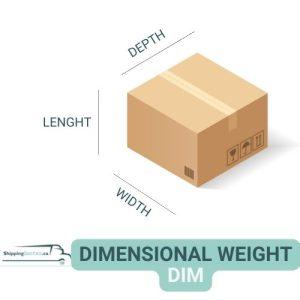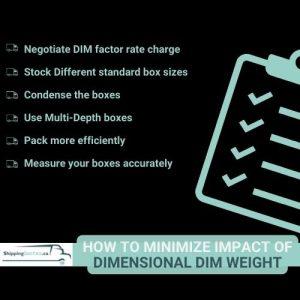Dimensional Weight, A Guide to reducing your bottom line due to DIM Weight when Shipping Parcels
The final cost of a shipment can be affected by the DIM Weight, rather than the actual weight. Therefore, understanding Dimensional Weight or DIM Weight is important.
*If you don’t like reading articles about, simply Contact Us us for a quick summary.
What is dimensional weight?

Dimensional (DIM) weight, otherwise known as volumetric weight, is the amount of space a package occupies, in relation to its actual weight. Moreover, it is a pricing strategy enabling carriers to account for both the actual weight of a package and the space it occupies.
Subsequently, carriers will charge whichever is the higher price whenever possible. Sometimes, it is based on dimensional weight because the amount of space utilized by a shipment costs more for airlines or trucking companies. For instance, imagine shipping a large box of feathers, weighing virtually nothing, versus a small box of bricks.
The EASIEST Way to Calculate Dimensional Weight
The best short cut is to simply use ShipBetter.ca, so that it automatically calculates DIM Weight, meanwhile determining the freight rate based on which weight type is higher! #convenience
Step by Step Method of Calculating Dim Weight:
Alternatively, find each carrier’s Dim Weight calculator:
How carriers calculate the final billable weight is a mystery to some
The following explains how carriers calculate freight rates based on packages’ dimensions and weight:
Step 1. Measure and Weigh the parcel
 Carriers use expensive and automated systems to measure its size and weight of each parcel.
Carriers use expensive and automated systems to measure its size and weight of each parcel.
Round up to the nearest whole number.
Step 2. Calculate dimensional weight
Next, use this formula:
DIM Weight = (Length*Width*Height)/ Dim Factor
The DIM Factor differs by carrier and service. DHL Express uses a DIM Factor of 139 (in/lb) or 5000 (cm/kg) for retail customers
Step 3. Look up billable weight and rate charge to calculate freight charge
Billable Weight = Whichever is Greater between DIM Weight vs. Actual Weight
Carriers calculate the freight rate based on the billable weight multiplied by the contracted rate charge for each destination zone.
Freight Charge = Billable Weight x Rate Charge
Step 4. Calculate total freight charge

Finally, add applicable accessorials like fuel, remote surcharge, extra handling, or residential delivery fee, etc. Additionally, sales taxes are based on the destination of where the freight it is going to.
Total Charge = Freight Charge + Applicable Surcharges
For example, the image calculates the freight rate of a 5lb 10″ cube from Toronto to San Francisco by DHL Express.
How to minimize the impact of Dimensional Weight?
The above example shows DIM Weight is higher. As a result, the billable weight of 8 lbs is 60% higher than the actual weight of 5 lbs. Depending on how and where the parcel is shipped, the final freight charge can be 30% more than estimated. Here are tips to minimize its impact of dimensional weight on your bottom line:
1.- Negotiate DIM Factor and rate charge
A higher DIM factor works in your favor to lessen the impact of dimensional weight. If you ship frequently, negotiate a different DIM factor with your carrier. For example, the difference between a DIM factor of 139 vs. 166 is a whole pound, meaning 20%! Rate charge per destination and weight has the highest factor in pricing. Thankfully, ShipBetter.ca negotiates the best rates for you.
2.- Stock different standard box sizes
It is difficult to efficiently pack if you only have one standard box size to choose from. However, stocking too many different boxes can be overwhelming. Therefore, a good balance is having about 10 different box sizes. Another cost-effective strategy is to ship multiple smaller boxes instead of one large parcel. Contact us for FREE SHIPPING SUPPLIES if you ship internationally.
3.- Condense the boxes
Cut down large boxes to decrease their DIM weight. Shaving off just one or two inches will save you a lot more down the road. This is especially for international, long-haul, or air express shipments.

4.- Use multi-depth boxes
When time is money and cutting down boxes is too time-consuming, invest in multi-depth boxes. It is easier and faster to reduce the height of multi-depth boxes than regular corrugated cardboard boxes. Here are examples from Uline.
5.- Pack more efficiently
Packing with less empty space will ultimately reducing your bottom line. Moreover, it is better for the environment.
6.- Measure your boxes accurately
Finally, measure each box carefully. It also provides evidence in case you need to dispute any reweighs. Manually measuring takes time, so use a slightly higher-end scale.
Final words
Hopefully, this article clears any confusion about how carriers calculate dimensional weight. Feel free to contact any ShippingQuotes.Ca hipping Consultant and we will help your company reduce the impact of dimensional weight.
